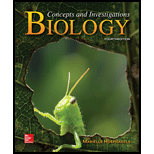
Concept explainers
To discuss:
About six plant families, weather they form monophyletic, paraphyletic, or polyphyletic group and also check that extrafloral nectries is an ancestral or a derived character in each of six families.
Concept introduction:
Paraphyletic group is the group of organism that includes an ancestor, but not all of its descendants. Polyphyletic group is a group of organism or other evolving organism that has been grouped together, but does not share an immediate common ancestor.
Monophyletic group is the group of organism that includes an ancestor and all of its descendants.
Extrafloral nectaries nectar is a sugar rich liquid produced by plant in glands called nectaries within the flower, which attracts pollinating animals.
Want to see the full answer?
Check out a sample textbook solution
Chapter 14 Solutions
Biology: Concepts and Investigations
- You are asked to survey an area and identify all plant and animal species you come across. On your survey, you come across a plant you are not familiar with and must do some research to figure out what it is. To do this, your first step is to determine whether this plant is classified in the class Monocotyledonae or a Eudicotyledonae. Explain how you can tell if this plant is a Monocot or Eudicot by describing the differences in their flowers, seeds, roots, stems, and leaves. 1.arrow_forwardAll plant families have a name that ends in “-aceae,” and some families also have old names, still commonly used, without this ending. The palms are a family with two names. What is the new name that ends in “-aceae,” and what is the older name? What kind of a compound leaf do the feather palms have? The fan palms? Why are palm flowers so seldom seen by most people?arrow_forwardThis figure identifies lineages as plants, non-vascular plants, vascular plants, seedless vascular plants, and seed plants. Which of these categories are paraphyletic and which are monophyletic?arrow_forward
- Members of the cactus family in North and South America and of the spurge family in Africa are very similar in structure. In both cases the plants live in desert environments. They have a succulent stem that stores water, no leaves (reduces water loss), stems that can perform photosynthesis, and spines that protect the plant from being eaten. The spines are formed from different parts of the plant in the two families. The two plant families are not closely related. The similarities between the two families is due to ______ which is caused by ________.arrow_forwardMake a parsimonious cladogram between the evolutionary connection of the following plants groups:arrow_forwardMake a schematic diagram of "Seed plant phylogeny inferred from all three plant genomes: Monophyly of extant gymnospersm and origin of Gnetales from conifers" by Shu-Miaw Chaw, Christopher L. Parkinson, Yuchang Cheng, Thomas M. Vincent, and Jeffrey D. Palmer.arrow_forward
- The leafy, green moss plants that are familiar are gametophytes, haploid plants. This is very different from flowering plants and other seed plants. Does a leafy green moss plant grow from a spore or from a fertilized egg? Does the moss plant have both paternal parent and maternal parent?arrow_forwardMonilophytes and seed plants both have megaphylls, as well as other traits not found in lycophytes. Explain this observation using the Figure in the picture and the concept of descent with modification.arrow_forward1 a) Describe the process of double-fertilization in this fireweed. b) What is the significance of this process in plant evolution?arrow_forward
- Now you will practice identifying the phylogenetic tree that corresponds to a given character table. The following table shows three key events in the evolution of plants: the development of vascular tissue, the development of flowers, and the development of seeds. Plant groups Vascular Tissue Flowers Seeds Gymnosperms 1 0 1 Mosses 0 0 0 Ferns 1 0 0 Angiosperms 1 1 1 Select the phylogenetic tree that correctly represents the data in the character table.arrow_forwardMatch the following taxa and descriptions to their corresponding and appropriate group or classification. Match each item to a choice: Also known as the Maidenhair Tree Family The leaves are palm-like, however, they are not related with the True Palms The Araucaria Family The pollen cones would bear leaf-life structures called microsporophylls while the seed cones would bear megasporophylls. The Yew Family The Cypress Family One of the most ancient plants that served as food for non-flying dinosaurs. The Pine Family This gymnosperm is a dioecious plant with fan-shaped leaves The Podocarp Family Choices: : Ginkgoaceae Сусadaceae : Ginkgoaceae Сусadaceae : Cycadaceae :: Тахасеае : Cupressaceae :: :::arrow_forwardFILL UP THE TABLE WITH 1=PRESENT AND 0=ABSENT Xylem Wood and Phloem Seeds Chloroplast Cuticle and Flower Chlamydomonas Marchantia Psilotum Gingko |xora Construct a phylogenetic tree for the following OTU and use bars to denote their apomorphiesarrow_forward
 Human Anatomy & Physiology (11th Edition)BiologyISBN:9780134580999Author:Elaine N. Marieb, Katja N. HoehnPublisher:PEARSON
Human Anatomy & Physiology (11th Edition)BiologyISBN:9780134580999Author:Elaine N. Marieb, Katja N. HoehnPublisher:PEARSON Biology 2eBiologyISBN:9781947172517Author:Matthew Douglas, Jung Choi, Mary Ann ClarkPublisher:OpenStax
Biology 2eBiologyISBN:9781947172517Author:Matthew Douglas, Jung Choi, Mary Ann ClarkPublisher:OpenStax Anatomy & PhysiologyBiologyISBN:9781259398629Author:McKinley, Michael P., O'loughlin, Valerie Dean, Bidle, Theresa StouterPublisher:Mcgraw Hill Education,
Anatomy & PhysiologyBiologyISBN:9781259398629Author:McKinley, Michael P., O'loughlin, Valerie Dean, Bidle, Theresa StouterPublisher:Mcgraw Hill Education, Molecular Biology of the Cell (Sixth Edition)BiologyISBN:9780815344322Author:Bruce Alberts, Alexander D. Johnson, Julian Lewis, David Morgan, Martin Raff, Keith Roberts, Peter WalterPublisher:W. W. Norton & Company
Molecular Biology of the Cell (Sixth Edition)BiologyISBN:9780815344322Author:Bruce Alberts, Alexander D. Johnson, Julian Lewis, David Morgan, Martin Raff, Keith Roberts, Peter WalterPublisher:W. W. Norton & Company Laboratory Manual For Human Anatomy & PhysiologyBiologyISBN:9781260159363Author:Martin, Terry R., Prentice-craver, CynthiaPublisher:McGraw-Hill Publishing Co.
Laboratory Manual For Human Anatomy & PhysiologyBiologyISBN:9781260159363Author:Martin, Terry R., Prentice-craver, CynthiaPublisher:McGraw-Hill Publishing Co. Inquiry Into Life (16th Edition)BiologyISBN:9781260231700Author:Sylvia S. Mader, Michael WindelspechtPublisher:McGraw Hill Education
Inquiry Into Life (16th Edition)BiologyISBN:9781260231700Author:Sylvia S. Mader, Michael WindelspechtPublisher:McGraw Hill Education





